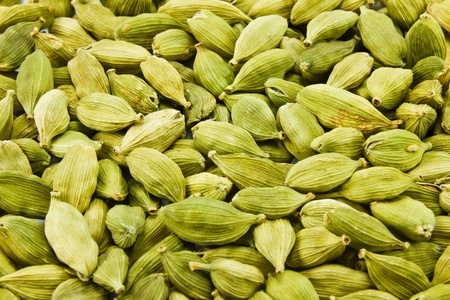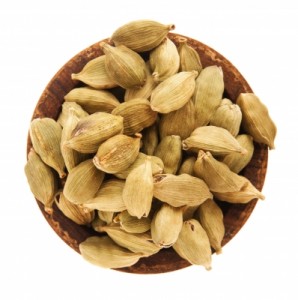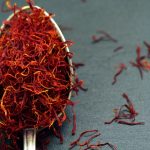
The spice, cardamom is made up of a variety of seeds from both the Elettaria and Amomum genera. One of the main species is Amomum subulatum Roxb. and sometimes known as ‘large’ or ‘black’ cardamom is a stalwart and characteristic flavour in Indian cooking. It has a very intense, almost slightly sweet flavour which reminds use of menthol for its pungency. Highly versatile, the spice also finds its way into sweet as well as savoury dishes.
The spice is also known in India as Badi Ilaychi or Brown Ilaychi and is a woody rhizomatous perennial in the Zingiberaceae or Ginger family. It imparts an earthy, woody note to curry, and is also a flavour component in Chai tea, but it has other significantly useful benefits. There is an excellent review by Gautam et al., (2016).
History
It is one of the world’s oldest spices. The ancient Egyptians chewed the seeds as a mouth cleanser and teeth cleaner whilst the Babylonians are claimed to be the first reported users of it in various condiments. The Ancient Romans and Greeks found its pungency a highly valuable base for perfumes. Constantinople was a vital link in the supply chain for this spice. It is believed the Vikings introduced the spice to their Scandinavian homelands from this great city of the Eastern Roman Empire where it became an integral part of their cooking, nearly a thousand years ago.
It is a native of Sikkim in the Himalayas and an extremely important cash crop in Nepal and India.
The spice is expensive. Only saffron is more costly per unit weight.
Cooking Applications Using Cardamom
The pods are used whole, split and even crushed when used in Indian cooking. It is a vital constituent in curries with its powerful and pungent aroma and flavour. Crushed and fried seeds are added to the pan for frying to impart these flavours to curries.
The Oleoresin And Its Benefits

The oleoresin was recently tested as a natural food preservative by a research group at Gorakhpur University in India in a classic storage study, to maintain quality of a sweet orange (Citrus sinensis) juice (Kapoor et al., 2011). The researchers maintained storage stability over 28 days at refrigerated temperatures and examined changes in factors such as pH, total and reducing sugars, vitamin C and microbial counts. Without any form of treatment the orange juice soon starts to ferment. Changes that occurred were probably due to chemical reactions during storage. Commonly, ascorbic acid degrades to dehydroascorbic acid and the sugar content increases as polymers breakdown too.
Recent research shows a methanolic extract of large Cardamom is effective against various enteropathogenic and food spoilage bacteria such as E. coli, Pseudomonas aeruginosa, Staphyloccocus aureus and Bacillus pumilus. The extract contained 10.75 mg/g dry weight of polyphenols which might be unexpected (Garg et al., 2016).
Components Found In Cardamom
Components identified in cardamom oil are 1,8-cineol (44%), α-terpineol (9.5%), terpinene-4-ol (3.2%), spathulenol (2.7%), germacrene, β-selinene and α-pinene (1.6%) (Gurudutt et al., 1998; Naik et al., 2004; Singh et al., 2006). One of the issues associated with the use of spice oils is that they impart unusual flavours when added to juices although this isn’t commented upon in the article. A highly developed examination of the volatile oils within the species is now available (Bhandari et al., 2017).
Potential Health Benefits Of Cardamom
Trying to prevent cancer through dietary intervention is steadily rising. Whilst we often look at the burgeoning evidence for what is in food that helps with all sorts of benefits, spices are attracting enormous interest in this regard (Zheng et al., 2016). Cardamom is one of those spices that may hold the key.
Cardamom has many compounds which are associated with killing cancer cells. There are a few studies in animals which suggest that these compounds influence enzymes that are part of the armoury of cancer-fighting. In one such study with mouse skin cancers, there was some chemoprotective action against a two-stage cancer (Qiblawi et al., 2012). The same lead author also contends that cardamom could act on cell lines associated with stomach cancer given the various actions it has on this type of cancer in mice Qiblawi et al., 2015).
Products
N.B. This article contains links to our affiliate marketing partners. Please read our disclaimer on affiliate marketing.
Purchase your cardamom products here
References
Gurudutt, K.N., Naik, J.P., Srinivas, P. Ravindranath, B.(1998) A comparison of the essential oils of Aframomum daniellii (Hook. F.) K. Schum. and Amomum subulatum Roxb. Flav. Frag. J. 13, pp. 349–352.
Kapoor, I.P.S., Singh, B., Singh, G. (2011) Essential Oil and Oleoresins of Cardamom (Amomum subulatum Roxb.) as natural food preservatives for sweet Orange (Citrus sinensis) Juice. J. Food Proc. Eng. 34 pp. 1101-1113
Naik, J.P., Rao, J.M., Mohan Kumar, T.M. and Sampathu, S.R. 2004. Chemical composition of the volatile oil from the pericarp (husk) of large Cardamom (Amomum subulatum Roxb). Flav. Frag. J. 19, pp. 441– 444
Qiblawi, S., Al-Hazimi, A., Al-Mogbel, M., Hossain, A., & Bagchi, D. (2012). Chemopreventive effects of cardamom (Elettaria cardamomum L.) on chemically induced skin carcinogenesis in Swiss albino mice. Journal of Medicinal Food, 15(6), pp. 576-580.
Qiblawi, S., & Dhanarasu, S. (2015). Chemopreventive effect of cardamom (Elettaria cardamomum L.) against benzo (α) pyrene-induced forestomach papillomagenesis in swiss albino mice. Journal of Environmental Pathology, Toxicology and Oncology, 34(2).
Singh, G., Maurya, S., Marimuthu, P., Kiran, S., Semwal, A.K. Bawa, A.S. (2006) Potential application of spice essential oils and oleoresins as natural food preservative in yoghurt, Part 58. Indian Perfumer 50, pp. 40–42.
Zheng, J., Zhou, Y., Li, Y., Xu, D. P., Li, S., & Li, H. B. (2016). Spices for prevention and treatment of cancers. Nutrients, 8(8), 495.
Revised: New references and extra material added. 27th March 2017. Updated 4th November 2019 with new purchasing options.

Really interested in this subject but are there other spices available I could use .?
Hi Kate, I noticed you commented on another post of mine. In terms of spices for food use, I’d suggest looking at those from India and North Africa which offer similar nutritional benefits. Turmeric, cumin, black mustard seed and onion seed contribute a range of flavours which add variety to dishes. Cardamom is quite polarising as a flavour but clearly favoured by many because it suggests a certain type of cuisine.
Cardamom has the best smell ever – just fresh and really fragrant. I always use these in the restaurant in Monmouth for our Indian dishes. Best to store in a clear glass jar and firmly lidded as they can taint other spices if you are not careful. I would recommend a supplier called Jalpur because of the quality of packaging. You can find it in Indian wholesalers but not the usual retailers unless you live in Reading or Slough.
Where I can I buy this please?